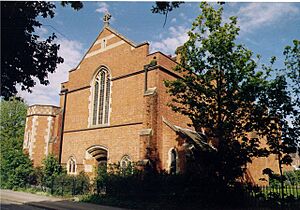Church of St Mark, Reading facts for kids
Quick facts for kids St Mark, Reading |
|
|---|---|
 |
|
| 51°27′16″N 0°59′54″W / 51.4544°N 0.9984°W | |
| OS grid reference | SU 696 733 |
| Location | Reading, Berkshire |
| Country | England |
| Denomination | Church of England |
| Tradition | Anglo-Catholic |
| Architecture | |
| Heritage designation | Grade II |
| Designated | 2007 |
| Architect(s) | Montague Wheeler |
| Architectural type | Parish church |
| Style | Arts and Crafts, Gothic |
| Groundbreaking | 1905 |
| Completed | 1906 |
| Specifications | |
| Materials | Red brick, slate, tile, stone |
| Administration | |
| Parish | St. Mark and All Saints |
| Diocese | Diocese of Oxford |
The Church of St Mark is a special Anglican church located in Cranbury Road, Reading, Berkshire, England. It is part of a larger church community known as the Parish of St. Mark and All Saints. This parish also includes another church, All Saints' Church.
Contents
The Church's Design and History
How St Mark's Church Was Built
The church building you see today was constructed between 1904 and 1905. However, the church actually began its life about 15 years earlier. It started as a "mission," which is like a smaller, simpler church set up to serve a local community.
The church was designed by Montague Wheeler, an architect from Reading, Scotland. His design mixes two main styles: the Arts and Crafts style and Gothic elements.
What St Mark's Church Looks Like
The church is mostly built from red bricks. These bricks are laid in a pattern called "English bond." You can also see some stone and tile decorations on the building. The roof is covered with slate tiles.
The church has beautiful stained glass windows. The windows on the western wall were created by artists Joseph Nuttgens and Reginald Hallward. On the eastern side, there is a larger window from 1905–1906. This one was made by Charles Eamer Kempe, another famous artist.
You might notice some large supports on the outside of the building. These are called flying buttresses. They help to hold up the walls and roof. On the north-west corner of the church, there is a tower with eight sides. This tower contains a staircase.
The Church Organ
Details of St Mark's Organ
The church has a large church organ that was put in place in 1912. It was built by a company called William Hill & Sons. The organ is located in a special area at the west end of the church. This area is decorated with paint and wooden panels.

